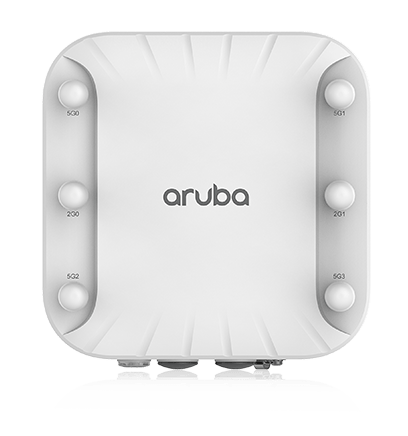- AP type:
- Indoor Hardened, Wi-Fi 6 dual radio, 5 GHz 4x4 MIMO and 2.4 GHz 2x2 MIMO
- Software-configurable dual radio supports 5 GHz (Radio 0) and 2.4 GHz (Radio 1)
- 5GHz:
- Four spatial stream Single User (SU) MIMO for up to 4.8 Gbps wireless data rate to individual 4SS HE160 Wi-Fi 6 client device (max)
- Two spatial stream Single User (SU) MIMO for up to 1.2 Gbps wireless data rate to individual 2SS HE80 Wi-Fi 6 client device (typical)
- Four spatial stream Multi User (MU) MIMO for up to 4.8 Gbps wireless data rate to up to four 1SS or two 2SS HE160 Wi-Fi 6 DL-MU-MIMO capable client devices simultaneously (max)
- Four spatial stream Multi User (MU) MIMO for up to 2.4 Gbps wireless data rate to up to four 1SS or two 2SS HE80 Wi-Fi 6 DL-MU-MIMO capable client devices simultaneously (typical)
- 2.4GHz:
- Two spatial stream Single User (SU) MIMO for up to 575 Mbps wireless data rate to individual 2SS HE40 Wi-Fi 6 client device (max)
- Two spatial stream Single User (SU) MIMO for up to 287 Mbps wireless data rate to individual 2SS HE20 Wi-Fi 6 client device (typical)
- Two spatial stream Multi User (MU) MIMO for up to 575 Mbps wireless data rate to up to two 1SS HE40 Wi-Fi 6 DL-MU-MIMO capable client devices simultaneously (max)
- Two spatial stream Multi User (MU) MIMO for up to 287 Mbps wireless data rate to up to two 1SS HE20 Wi-Fi 6 DL- MU-MIMO capable client devices simultaneously (typical)
- Support for up to 512 associated client devices per radio, and up to 16 BSSIDs per radio
- Supported frequency bands (country-specific restrictions apply):
- 2.400 to 2.4835 GHz
- 5.150 to 5.250 GHz
- 5.250 to 5.350 GHz
- 5.470 to 5.725 GHz
- 5.725 to 5.850 GHz
- 5.850 to 5.925 GHz
- 5.825 to 5.875 GHz
- Available channels: Dependent on configured regulatory domain.
- Dynamic frequency selection (DFS) optimizes the use of available RF spectrum.
- Supported radio technologies:
- 802.11b: Direct-sequence spread-spectrum (DSSS)
- 802.11a/g/n/ac: Orthogonal frequency-division multiplexing (OFDM)
- 802.11ax: Orthogonal frequency-division multiple access (OFDMA) with up to 16 resource units (RU)
- Supported modulation types:
- 802.11b: BPSK, QPSK, CCK
- 802.11a/g/n: BPSK, QPSK, 16-QAM, 64-QAM, 256-QAM (proprietary extension)
- 802.11ac: BPSK, QPSK, 16-QAM, 64-QAM, 256-QAM, 1024-QAM (proprietary extension)
- 802.11ax: BPSK, QPSK, 16-QAM, 64-QAM, 256-QAM, 1024-QAM
- 802.11n high-throughput (HT) support: HT 20/40
- 802.11ac very high throughput (VHT) support: VHT 20/40/80/160
- 802.11ax high efficiency (HE) support: HE20/40/80/160
- Supported data rates (Mbps):
- 802.11b: 1, 2, 5.5, 11
- 802.11a/g: 6, 9, 12, 18, 24, 36, 48, 54
- 802.11n (2.4GHz): 6.5 to 300 (MCS0 to MCS15, HT20 to HT40)
- 802.11n (5GHz): 6.5 to 600 (MCS0 to MCS31, HT20 to HT40)
- 802.11ac: (5 GHz): 6.5 to 3,467 (MCS0 to MCS9, NSS = 1 to 4 for VHT20 to VHT160)
- 802.11ax (2.4GHz): 3.6 to 574 (MCS0 to MCS11, NSS = 1 to 2, HE20 to HE40)
- 802.11ax (5GHz): 3.6 to 4803 (MCS0 to MCS11, NSS = 1 to 4, HE20 to HE160)
- 802.11n/ac packet aggregation: A-MPDU, A-MSDU
- Transmit power: Configurable in increments of 0.5 dBm
- Maximum (conducted) transmit power (limited by local regulatory requirements):
- 2.4 GHz band: +22 dBm per chain , +25 dBm aggregate (2x2)
- 5 GHz band: +22 dBm per chain , +28 dBm aggregate (4x4)
- Note: conducted transmit power levels exclude antenna gain.
- Maximum EIRP (limited by local regulatory requirements):
- 2.4 GHz band: 25 dBm + Antenna Gain
- 5 GHz band: 28 dBm + Antenna Gain
- Advanced Cellular Coexistence (ACC) minimizes interference from cellular networks.
- Maximum ratio combining (MRC) for improved receiver performance.
- Cyclic delay/shift diversity (CDD/CSD) to enable the use of multiple transmit antennas.
- Short guard interval for 20-MHz, 40-MHz, 80-MHz and 160-MHz channels.
- Space-time block coding (STBC) for increased range and improved reception.
- Low-density parity check (LDPC) for high-efficiency error correction and increased throughput.
- Transmit beam-forming (TxBF) for increased signal reliability and range.
|



